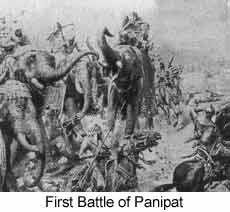

 |  |
 It was on this scene that the Mughal or Turkish chief Babur appeared in the year 1517. He was trying to recover in one direction what he had lost in others. Babul's dynasty is entitled Mughal or Mongol but it should in fact be thought of as Turkish, which language they spoke. Turk and Mongol had been intermixed in the ebb and flow of Central Asian intertribal warfare. Babur was fifth in descent from the great Taimur. His father's kingdom was reduced to the small principality of Farghana in Badakshan.
It was on this scene that the Mughal or Turkish chief Babur appeared in the year 1517. He was trying to recover in one direction what he had lost in others. Babul's dynasty is entitled Mughal or Mongol but it should in fact be thought of as Turkish, which language they spoke. Turk and Mongol had been intermixed in the ebb and flow of Central Asian intertribal warfare. Babur was fifth in descent from the great Taimur. His father's kingdom was reduced to the small principality of Farghana in Badakshan.Babur suceeded as a boy of eleven in 1494 but soon found himself threatened by the Uzbeg chief Shaibani Khan. He was soon a fugitive and spent years between 1494 and 1513 trying to maintain himself in Farghana and recover Samarkand. In 1504, in one of the turns of north-western politics, he gained control of Kabul and Kandahar. Gradually he merged these two districts with Badakshan and formed a personal kingdom which for him was a compensation for the loss of Samarkhand. But his over ambitious attitude made him look towards India as a southern expansion of his fledgling empire. During his frequent raids to India he had noticed the wealth and prosperity there. He had also noticed the disunity and disaffection which prevailed in the region. It was a easy prey for a fugitive like him. But the real invitation came when the Afgan governor of Punjab disillusioned my Ibrahim Lodhi's pretensions invited him to invade India and replace Ibrahim Lodhi. Babur took his cue with the two invasions of 1523-24 and 1525-26 leading up to the battle of Panipat on 21 April 1526. The first battle of Panipat The battle was fought only fifty miles from Delhi. In the fight Babur was heavily outnumbered by an army stiffened with a hundred elephants. On his side, however, he had the strength of loyalty in a compact group, cavalry which could maneuver skillfully on the wings, and the new artillery from Turkey commanded by a Turkish officer. It was these factors which proved decisive and the day ended with the death of Ibrahim Lodhi on the field and the flight of his great army. There was no national rally, because the country was not interested in the fortunes of these alien aristocrats. As for the local Afgan chieftains of Ibrahim Lodhi they waited with baited breath for Babur to leave, after his job was accomplished. But Babur had other things in mind. Babur pushed on from Delhi to Agra where his first act was to lay a garden in Persian style. But the sight he left behind wherever he went was of plunder and loot. In Agra he faced his first real challenge, the Hot weather. His chiefs & generals were not ready to move further, they wanted to go back to the cool environs of Hindu Kush. As it was not enough that then came the challenge from the Rajputs who were for the first time unitedly challenging the foreign rule. They were under the ablest leader Rana Sanga. next page >> |
Copyright ©2000 indiansaga.info. All rights reserved.
By using this service, you accept that you won't copy or use the data given in this website for any commercial purpose.
The material on indiansaga.info is for informational & educational purpose only.
This site is best viewed at 800 X 600 picture resolution.